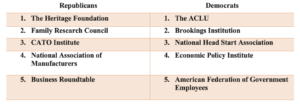
Republicans and Democrats in Congress can agree, it appears, on something: Whom to follow on X (formerly Twitter). Across party lines, these six leaders and celebrities emerged as some of the most-followed:
A sample of the most-followed celebrities and CEOs (Republican and Democrat, 117th Congress)
- The Pope (20%)
- Bill Gates (17%)
- Oprah (13%)
- Elon Musk (12%)
- Lebron James (6%)
- Tim Cook (4%)
X (Twitter) is a rich place to study the US Congress. More than 98% of its members are active on the platform. Every day these members collectively tweet hundreds—sometimes thousands—of messages.
Brunswick Insight analyzes those tweets to glean real-time insights about conversations, and to see and study broader trends—ones that can be obscured by the disproportionate focus that the loudest voices attract.
Through this lens, we can provide data-driven answers to questions like: What’s on Congress’s mind? Have members publicly taken a position on an issue—and if so, how many, and who might still be undecided? What reactions have taken place to a specific issue, event, or company—and how do those reactions trend over time? Does the media’s coverage of Congress give a fair picture of what its members are talking about?
We analyzed Congressional tweets across a variety of healthcare-related issues, for example, to understand the topics driving Congressional conversations across party lines. The topics eliciting the most tweets: Medicare, mental health, healthcare costs, and drug pricing. Some of those tweets were run-of-the-mill talking points. Yet there were also nuanced discussions of pieces of legislation, and how those pieces fit into Congress’s agenda—useful for some our healthcare clients to know.
We’ve analyzed how Congress was tweeting about content moderation, big tech regulation, social media, ESG, COVID-19, China, infrastructure, cybersecurity, banking—along with many, many other issues, keywords or brand names.
We analyze not only what Congress is saying, but also the accounts making it into their feeds.
Most-Followed News Sources:

Most-Followed Think Tanks, Associations and Federations:

It’s not news that Republicans follow Fox News, or that Democrats read The Washington Post, but knowing the full list of those outlets and organizations—and how they vary for certain members—can help increase the chances of your argument or story actually reaching the people you want.
There are, of course, shortcomings to any research that relies on social media—X (Twitter), as we’ve been reminded of many times, isn’t representative of the wider world. But given that practically every member of Congress (or a staffer) is both on X and active on the platform, it is a fair representation of this influential group.
For clients, this type of analysis can extend to any group, not just Congressial members. How are conversations evolving among their peer companies, for instance, or within a specific sector? How are Fortune 500 CEOs talking about their businesses? Who are the “ESG influencers” driving the conversation? What about AI?
Threads, Meta’s new social media platform that allows users to share text and photos, can’t be studied in quite the same way yet, and its senior leaders have said the platform “isn’t for news and politics.” Still, it might become another platform where politicians look to get their message out—and another place where analysis can help sift through the ever-present noise to find the all-elusive signal.
—
Zayd Mabruk is an Associate with Brunswick Insight based in Dallas.

